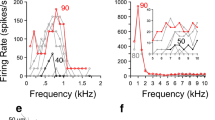Abstract
The response properties of jittery movement fibers (JMF) in the crayfish optic tract reacting to a non-moving temporally patterned light were analyzed. The JMFs usually show no response during the regular flickering of stationary light with a flash duration of less than 50 msec when the stimulus frequency is between 4 and 20 per second; however they do respond when the flickering stops if a certain number of flashes have been given. The response appears about 50 msec after the first missing flash, i.e., the latency of the response after the last flash of the train changed from 100 to 300 msec. Thus, the “off” response at the end of the flicker is entrained to the stimulus repetition interval and locked onto the time of the first missing flash. The response of a sustaining fiber to an identical stimulus has quite different features as illustrated in Fig. 2. Some of the fibers show responses to the beginning part of the flicker but not necessarily to each flash, and habituate after several flashes. When a single flash longer than 250 msec is given, the fiber shows an “off” response with about 50 msec latency, as it does to sustained light. Some fibers show a double burst of “off” discharge to single flashes; the first at 50 msec is followed after 120 msec by the second one. However, when the flash duration is between 250 and 50 msec, a single flash elicits little or no response. The latency of the “off” response is as much as 300 msec for short single flashes less than 50 msec. An “on” response to flashes of light is observed when the inter-stimulus interval is more than 5 sec. The responses to the beginning part of flicker train are not simply locked to the just preceding flash except the “on” response to the very first one, but they can be the long latency responses to the flash before that. This response is modified in latency by the succeeding flashes in flicker trains and becomes entrained to the missing flash. Four types of entrainment are classified on the basis of the change in latency from the missing flash with regard to the number of flashes in a train. In most cases, 10 flashes are sufficient to entrain the response to the first missing flash. Non-resposiveness, i.e., habituation, during a regular flicker, may be due to an active inhibitory process, initiated by each succeeding light pulse. The response to the missing flash, therefore results from a disinhibited modified response to the last flash. Some JMFs continue to respond to the flicker even after a considerable number of flashes but only when the repetition interval is about 120 msec corresponding well to the interval of the double burst “off” discharge, thus the JMF has a resonant frequency of about 8 Hz. The JMFs appear to be acting as an irregularity detector in temporal sequence.
Similar content being viewed by others
References
Barlow, H. B., Hill, R. M., Levick, W. R.: Retinal ganglion cells responding selectively to direction and speed of image motion in the rabbit. J. Physiol. (Lond.) 173, 377–407 (1964)
Collet, T.: Visual neurons in the anterior optic tract of the privet hawk moth. J. comp. Physiol. 78, 396–433 (1972)
Etienne, A. S.: Die Beantwortung von Flimmerfrequenzen durch die Libellenlarve Aeschna cyanea M. Z. vergl. Physiol. 61, 34–40 (1968)
Glantz, R.: Peripheral versus central adaptation in the crustacean visual system. J. Neurophysiol. 34, 485–492 (1971)
Grüsser, O. J., Grüsser, C. U., Finkelstein, D., Henn, V., Patutschnik, M., Buttenandt, E.: A qualitative analysis of movement detecting neurons in the frog retina. Pflügers Arch. ges. Physiol. 293, 100–106 (1967)
Himstedt, W.: Zur Funktion eines Reizfiltermechanismus im visuellen System von Urodelen. Z. vergl. Physiol. 62, 197–204 (1969)
Horn, G., Rowell, C. H. F.: Medium and long term changes in the behavior of visual neurons in the tritocerebrum of locust. J. exp. Biol. 49, 143–169 (1968)
Horridge, G. A., Burrows, M.: Tonic and phasic system in parallel in the eyecup responses of the crab Carcinus. J. exp. Biol. 49, 269–284 (1968)
Loftus-Hills, J. J.: Analysis of an Acoustic Pacemaker in Strecker's Chorus Frog, Pseudacris streckeri (Anura: Hylidae). J. comp. Physiol. 90, 75–87 (1974)
Meyer, W. H.: Visuelle Schlüsselreize für die Auslösung der Beutefanghandlung beim Bachwasserläufer Velia caprai (Hemiptera, Heteroptera). 2. Untersuchung der Wirkung zeitlicher Reizmuster mit Flimmerlicht. Z. vergl. Physiol. 72, 298–342 (1971)
Mimura, K.: Neural mechanisms subserving directional selectivity of movement in the optic lobe of the fly. J. comp. Physiol. 80 (1972)
Palka, J.: An inhibitory process influencing visual responses in a fiber of the ventral nerve cord of locusts. J. Insect Physiol. 13, 235–248 (1967)
Shaw, S. R.: Optics of arthropod compound eye. Science 165, 88–90 (1969)
Shimozawa, T., Takeda, T., Yamaguchi, T.: Movement perception by the movement fiber in the optic tract of the crayfish—analysis of temporal factors in movement perception (in Japanese). Jap. J. Med. Electr. Bio. Engng. 10, 186–195 (1972)
Wiersma, C. A. G., Yamaguchi, T.: The neuronal components of the optic nerve of the crayfish as studied by single unit analysis. J. comp. Neurol. 128, 333–358 (1966)
Wiersma, C. A. G., Yamaguchi, T.: The integration of visual stimuli in the rock lobster. Vision Res. 7, 197–204 (1967)
Wiersma, C. A. G.: Neuronal components of the optic nerve of the crab, Carcinis maenas. Proc. Koninkl. Nederl. Akad. Wetensch. C 73, 25–34 (1970a)
Wiersma, C. A. G.: Reactivity changes in crustacean neural systems. In: Hinde, A. R. (Ed.): Short-term changes in neural activity and behavior, pp. 211–236. London: Cambridge University Press 1970b
Yamaguchi, T., Ohtsuka, T., Katagiri, Y., Shimozawa, T.: Some spatial and temporal properties of movement fibers in the optic tract of the crayfish. J. Fac. Sci. Hokkaido Univ., Ser. VI, Zool., 19, 31–48 (1973)
Author information
Authors and Affiliations
Rights and permissions
About this article
Cite this article
Shimozawa, T. Response entrainment of movement fibers in the optic tract of crayfish. Biol. Cybernetics 20, 213–222 (1975). https://doi.org/10.1007/BF00342641
Received:
Issue Date:
DOI: https://doi.org/10.1007/BF00342641




